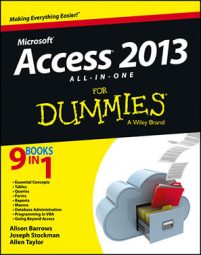If you’re a user of Access 2000 through 2010, you may be familiar with Access Data Project (ADP) files — Access data files that provide access to SQL Server databases. Access 2013 drops support for the ADP format, and Microsoft recommends one of the following alternatives:
Continue using the same version of Access. ADPs continue to work in earlier versions of Access. They won’t work, however, with newer versions of SQL Server such as SQL Server 2012 and SQL Server Azure.
If you upgrade (or your organization upgrades) to versions of SQL Server newer than your current version of Access knows about, your ADPs will no longer function properly.
Convert to an Access Custom Web App. In Access 2013, you can import your tables into a new Access app, and Access automatically creates forms for your application. You can extend the functionality of the base forms that Access creates for you so that other people can use your application on the web. Although some of the functionality that you use in ADPs may no longer be available, expect Microsoft to continue to focus improvements in the product on this application type.
Convert to a linked desktop database. Access 2013 continues to support creating desktop databases in .accdb file format. You can convert your application to the .accdb format — including all your existing forms and reports — and leave the data in SQL Server. Then you can link to the SQL Server database by using linked tables, and your application will continue to operate.
Create a hybrid application. If your application is large, and you don’t want to convert everything at the same time, you can import your data into an Access app and link to the SQL Server database from an .accdb file. This method allows you to migrate gradually, adding forms and functionality to your Access app over time app while maintaining your client application as an .accdb file with tables linked to the SQL Server database behind the Access app.
Upgrade to the .NET Framework. Your application may be complex enough for you to consider moving to a more robust development platform, such as the .NET Framework. SQL Server is designed to make it easy for you to use the database infrastructure you’ve already created and extend the functionality of your application without having to significantly rewrite your code.
When you’re working with data from SQL Server (or another data source), the data is coming from somewhere other than Access. After you establish the connection to the server and the database, you can build the rest of your Access objects — forms, reports, macros, and modules — to create a robust front end to an SQL Server database.

